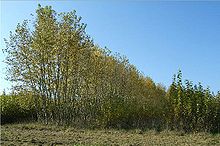Energy wood

With energy wood is wood designated exclusively for the energy to be used by combustion. In principle, such energetic use is possible with all wood. In practice, however, there are numerous higher-quality uses for wood, which is then used as a material , i.e. through processing in sawmills, paper mills and in other wood- producing companies . That is why only inferior wood assortments from the forest, wood used in short rotation plantations or Silvopastoral systems as energy crops , residual wood from the wood processing industry, and waste wood are treated as energy wood.
use
The wood used for energy can be burned in the heaters and chimneys of private houses. In this case, firewood chopped into manageable logs is used, which usually comes directly from the forest or has also been available in hardware stores for a few years. However, it is also possible to refine it beforehand into wood chips , wood pellets or wood briquettes . Energy wood is also used to produce charcoal and wood gas .
On a large scale, however, wood is mainly used in industry. The Renewable Energy Sources Act promotes the feed-in of electricity that can be generated during combustion in industrial plants. Black liquor plays a major role in this. This consists for the most part of the lignin that occurs during pulp production , the substance that makes up about half of the dry matter in wood. Black liquor is usually burned or converted into electricity directly in the corresponding pulp mills. Other wood processing companies such as sawmills also produce a significant amount of residual wood. If there is no energetic use directly in the companies, this residual wood is mostly sold to heating or electricity works, which can provide this wood with the appropriate technical equipment, or which only use biological energy sources.
The use of used wood (used furniture , timber , transport packaging and the like) is problematic because it can be contaminated by impurities and foreign and unknown in energy recovery pollutants would be released. It is more advantageous to use natural wood, which is not only obtained from forestry and as residual wood from wood processing companies, but also from landscape and fruit tree maintenance. The energetic use of less polluted waste wood is possible under certain conditions. Heavily contaminated material, on the other hand, has to be deposited.
meaning
On a global scale, wood is still one of the most important energy sources. In many countries, wood is still used for heating and cooking in rural areas. The great demand for energy wood also led to a shortage of wood at the end of the 18th century in Central Europe, one consequence of which was the substitution of wood by fossil fuels in the 19th and 20th centuries.
Today the importance of wood in this regard is increasing again. For the forestry industry there are important opportunities to increase sales, especially of poorly marketed assortments. In recent years, the increased demand for firewood has made a decisive contribution to improving the economic situation of many forest operations, including those of the state and local authorities.
An important advantage of wood or bioenergy in general is that it is suitable for base loads : While other renewable energies have strong fluctuations in their generation, for example wind energy , wood can guarantee a minimum amount of available energy at all times. It is therefore an important part of the energy mix . However, due to the scarcity of wood as a resource, there are natural limits to the growth of this sector.
Despite the steadily increasing forest area of currently 32% of the national area and the largest absolute wood supply in Europe, the proportion of wood in total energy production in Germany is only around 3%. On the other hand, there are also wooded countries in Europe such as Sweden or Finland , for which the development of the wood energy sector is of relatively great importance. In Europe, Latvia has the highest share of wood in total energy production (35%).
See also
literature
- Manuela Bärwolff, Hermann Hansen, Martin Hofmann, Frank Setzer: Energy wood production from agriculture. Published by the Agency for Renewable Raw Materials (FNR). 5th, revised edition. Gülzow 2012 ( PDF ; 5.2 MB).
Web links
- Energy wood portal
- Bavarian State Institute for Forests and Forestry (LWF): Wood energy
- Energy wood potential study for the Aachen / Eifel area (PDF file; 2.60 MB)
- waldwissen.net : The SRC calculator - economic efficiency of short rotation plantations
- Guideline for the efficient and environmentally friendly production of energy wood (Thuringian State Agency for Agriculture) (PDF file; 60 kB)
swell
- ↑ § 2 of the Waste Wood Ordinance
- ↑ Third National Forest Inventory 2012: Forest Country Germany - Forest area constant
- ↑ Michael Köhl, Ewald Rametsteiner: The State of Europe's Forests: 2007 - Report of the Fifth Ministerial Conference on the Protection of Forests in Europe for Sustainable Forest Management in Europe. MCPFE Liaison Unit Warsaw, Warsaw 2007. In: Peter Spathelf: Sustainable Forest Management in a Changing World: a European Perspective. Managing Forest Ecosystems, Issue 19, Springer, Dordrecht 2009, pp. 53-60, ISBN 83-922396-8-7 .